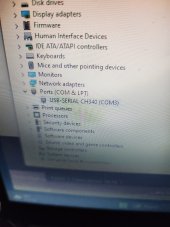Bfreemannh
New Member
- Joined
- Nov 12, 2022
- Messages
- 10
Hi Folks,
I am trying to update my 6000ex inverter but getting an error.
I am using the supplied black two wire USB to RJ45 cable. The rj45 jack is plugged into the far-right computer port on the inverter.
When I insert the USB cable port 3 or port 4 is assigned depending on what USB port I use. The update tool always defaults to the right port. When I press update it claims to open the port, then fails to connect, and then closes the port.
This is using a fresh win11 build with nothing installed and no other connections but Wi-Fi.

 What am I doing wrong
What am I doing wrong
I am trying to update my 6000ex inverter but getting an error.
I am using the supplied black two wire USB to RJ45 cable. The rj45 jack is plugged into the far-right computer port on the inverter.
When I insert the USB cable port 3 or port 4 is assigned depending on what USB port I use. The update tool always defaults to the right port. When I press update it claims to open the port, then fails to connect, and then closes the port.
This is using a fresh win11 build with nothing installed and no other connections but Wi-Fi.

 What am I doing wrong
What am I doing wrong


